
Lesson Plan geared towards a civic engagement project for students. Focused on voting rights in states.
- Subject:
- Social Science
- Material Type:
- Lesson Plan
- Provider:
- Teaching Civics Through History
- Date Added:
- 03/22/2024

Lesson Plan geared towards a civic engagement project for students. Focused on voting rights in states.

This lesson plan explores the political conflicts of the early republic. Explore the different political beliefs of Washington's presidency, and how they were able to work things out.

This classroom poster reminds students of three key questions to ask when evaluating information online: Who's behind the information? What's the evidence? What do other sources say? The file is designed to be printed on 18" by 24" paper. Note: A free educator account is required to access these materials.
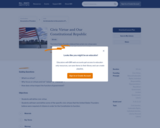
The United States Founders believed that certain civic virtues were required of citizens in order for the Constitution to work. Numerous primary sources—notably the Federalist Papers and the Autobiography of Ben Franklin—point us to the "Foundersâ" Virtues." Before exploring the Documents of Freedom, it is important to understand civic virtue as an essential element of self-government.

Nebraska’s PBS Station presents a series of short videos aimed at helping students understand the basic concepts of local and national government. From the unique Nebraska Unicameral, to the branches of Federal government, to the process of how an idea becomes a law through the legislative process, Civics 101 is a video collection produced to remind viewers how our government foundations came to be and how they continue to shape the operation of local and national government.
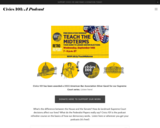
Engaging, teacher-created lesson plans on the Constitutional Convention, Freedom of Speech, 4th Amendment, Electoral College, Federalist and Federalism, more.
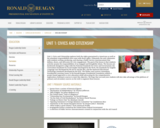
Explores the rights guaranteed to Americans as well as the attendant responsibilities that come with those rights...The Walter and Leonore Annenberg Presidential Learning Center at the Ronald Reagan Presidential Foundation utilizes a project based approach to civic education while advocating for the comprehensive exploration of primary sources to meet this objective.

This resource from the National Constitution Center includes an introduction, big questions, recorded class sessions, briefing documents, slide decks, and worksheets to help teach students the importance of civil dialog related to the United States Constitution.
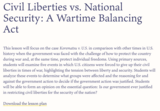
This lesson will focus on the case Korematsu v. U.S. in comparison with other times in U.S. history when the government was faced with the challenge of how to protect the country during war and, at the same time, protect individual freedoms. Using primary sources, students will examine five events in which U.S. citizens were forced to give up their civil liberties in times of war, highlighting the tension between liberty and security. Students will analyze these events to determine what groups were affected and the reasoning for and against the government action to decide if the government action was justified. Students will be able to form an opinion on the essential question: Is our government ever justified in restricting civil liberties for the security of the nation?
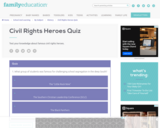
Test your knowledge about famous civil rights heroes.
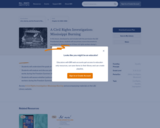
In this lesson, developed by and included with the permission the LBJ Presidential Library, students will use primary source documents to investigate the disappearance of three civil rights workers during the Freedom Summer of 1964.

The civil rights movement was a struggle for social justice that took place mainly during the 1950s and 1960s for Black Americans to gain equal rights under the law in the United States. This website reviews some of the major events from the 1960s regarding Civil Rights.

Try out Search Coach and Domains when researching Civil Rights: The Chicano Movement.

Throughout 2015, events across the nation focused attention on concerns in minority communities and racial perceptions in America, resulting in renewed public dialogue about race relations and other issues of social justice. This ongoing dialogue includes not only questions about the policing of black communities, but also educational inequality and the school-to-prison pipeline, the LGBTQ rights movement, immigration reform, and the rebuilding of our communities. Join us for a special youth town hall discussion about race, racism and other issues of equality in the United States in 2016. Answering these important student questions about activism, education, and building a diverse community are a panel of experts including Robert Henderson from POV's documentary All the Difference.
This final episode of Project C encourages students to think critically about current issues of equality, to examine, confront and strive to overcome contemporary injustices in their lives and communities. This live interactive webcast is an innovative platform for the presentation of their solutions to these civics-based issues.
Sensitive: This resource contains material that may be sensitive for some students. Teachers should exercise discretion in evaluating whether this resource is suitable for their class.

The African-American Civil Rights movement is typically seen as having taken place mostly in the 1950s and 60s, when a confluence of social and economic factors enabled political change. The movement, however, has much deeper roots, and thus our toolkit starts in the 19th Century, some two generations before leaders like King, Parks, and others were born. Viewing the Civil Rights movement as a generational one provides a broader perspective on the ideas and people at the foundation of this work to achieve “a more perfect union” for all Americans. This toolkit provides guiding questions and links to essential documents, resources, and lesson plans related to the Civil Rights movement.

An overview of the prosperity of the 1950s and the growing civil rights movements during this decade for desegregation and equal treatment.
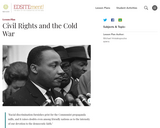
This lesson plan attempts to dissolve the artificial boundary between domestic and international affairs in the postwar period to show students how we choose to discuss history.

This 2 min video examines the 13, 14, and 15th amendments to the constitution within 5 years. They discuss what they did and how they helped to ensure freedoms for all Americans.

This lesson plan utilizes a video and question guide to help students understand the Civil War. The video breaks down the Civil war into short animated clips to help students understand the events of the American Civil War, and students learn by responding to a set of questions.

Explore a gallery of Civil War artillery, ordnance, and military supplies. The Civil War was fought in 10,000 locations across the United States. More than three million men fought in battle, and more than 600,000 lost their lives to injuries and disease.